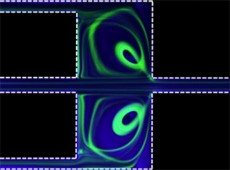Microfluidic Breakthroughs Offer New Options for Ease and Accuracy in Extraction of Rare Cells or Separating Blood
Using something called "inertial microfluidics," University of Cincinnati researchers are able to continuously and selectively collect rare cells, such as circulating tumor cells, based on their size vs. other biomarkers. This could reduce analysis time and increase selectivity while reducing reliance on antibody-based testing in clinical tests.
"Last year we showed we can selectively isolate prostate cancer cells, but only by running small sample volumes one at a time. Now we show that we can do this continuously," Papautsky said. "This is exciting because it allows for an entire blood draw to be processed, in continuous matter, in a shorter period of time."

This image shows the size-dependent extraction of particles. The fluorescent image indicates trapping of larger particles while smaller particles pass through.
These blood draws can be used to identify tumor cells for diagnostic or prognostic purposes. "Our approach is based purely on size. It doesn't rely on antibodies, which is important because not all cancer cells express antigens. So, if the cancer cells are, let's say, larger than 20 microns, we'll extract them," he explained.
The most common approach for looking for these circulating tumor cells is via a system that uses a selection using antibodies to detect antigens. "We could also use our device to prepare samples for systems that use antibody-based selection." This combined approach could potentially help reduce occurrence of false positives while significantly increasing the accuracy of the antibody-based tests.
Another area in which this device could be useful is in working with cell cultures. "If you have a mixture of multiple cells where some cells are small and other cells are big, we could separate these cell populations very easily," Papautsky explained. "Anytime you need to separate based on size, we can do it using inertial microfluidics."
The advantage of inertial microfluidics in cell separation is that it can be done easily and without cumbersome equipment. This research is leading to an entirely new generation of testing capabilities which particularly lend themselves to direct use in the field and in physicians' offices in just about any country and any economic setting.
Another of "Sorting of Blood in Spiral Microchannels" Papautsky and doctoral student Nivedita Nivedita demonstrate continuous sorting of blood utilizing inertial microfluidics via a simple passive microfluidic device. Papautsky's lab has been developing the concept of using inertia to manipulate cells and particles during the last few years. "It's truly different and innovative because these microfluidic devices are really low cost while offering very high throughput," said Papautsky.
The device is, essentially, a clear, plastic, flexible square that is relatively small in size, at about a half an inch across, but big in concept. "With this particular device we can take a drop of blood, put it in the input port in the center, and separate," Papautsky explained. The device contains four outlet ports which separate the blood into different streams, allowing the collection of outputs containing dilute plasma, red blood cells and white blood cells.
The most common approach for looking for these circulating tumor cells is via a system that uses a selection using antibodies to detect antigens. "We could also use our device to prepare samples for systems that use antibody-based selection." This combined approach could potentially help reduce occurrence of false positives while significantly increasing the accuracy of the antibody-based tests.
Another area in which this device could be useful is in working with cell cultures. "If you have a mixture of multiple cells where some cells are small and other cells are big, we could separate these cell populations very easily," Papautsky explained. "Anytime you need to separate based on size, we can do it using inertial microfluidics."
The advantage of inertial microfluidics in cell separation is that it can be done easily and without cumbersome equipment. This research is leading to an entirely new generation of testing capabilities which particularly lend themselves to direct use in the field and in physicians' offices in just about any country and any economic setting.
Source: Nanotechnology Now
- 453 reads
Human Rights
Fostering a More Humane World: The 28th Eurasian Economic Summi

Conscience, Hope, and Action: Keys to Global Peace and Sustainability

Ringing FOWPAL’s Peace Bell for the World:Nobel Peace Prize Laureates’ Visions and Actions

Protecting the World’s Cultural Diversity for a Sustainable Future

Puppet Show I International Friendship Day 2020

